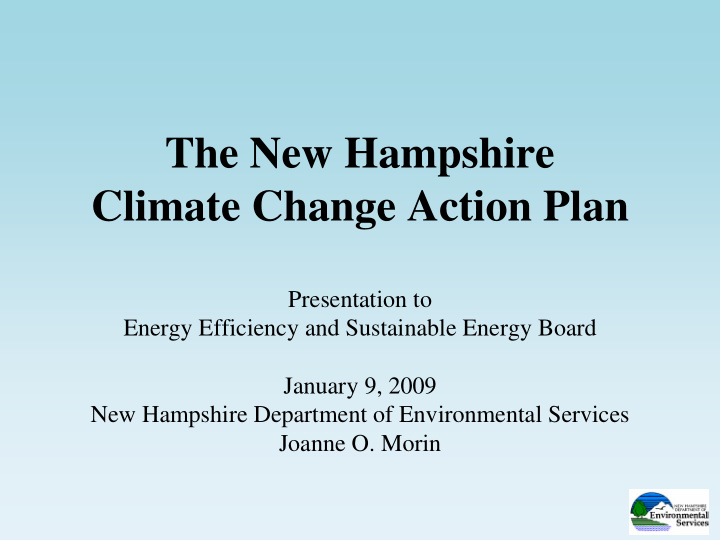



The New Hampshire Climate Change Action Plan Presentation to Energy Efficiency and Sustainable Energy Board January 9, 2009 New Hampshire Department of Environmental Services Joanne O. Morin
Climate Change Policy Task Force Membership Twenty-nine (29) members • State agency commissioners; • House and Senate members; • General commerce and industry; • Environmental interests; • Forestry sector; • Science/academia; • Public utilities; • Municipal government; and • Insurance industry.
Technical and Policy Technical and Policy Working Groups Working Groups • Six (6) Working Groups • 125+ Participants – Local Energy Committee Members – Planners – State Agency Staff – Task Force members – Non-profit – Tradespeople – Lobbyists
Public Involvement Public Involvement & Social Networking & Social Networking • Six (6) Official Listening Sessions – 15 Locations – 275 Participants – 100 Commenters • Invited presentations to Local Energy Committees; Environmental Groups; BIA • Targeted outreach to groups that did not participate in the Working Group process • 100+ Written Comments
Draft Task Force Principles • Reduce greenhouse gas emissions to 80% below 1990 levels by 2050. • Create economic opportunity, while considering all costs and benefits. • Focus investments in a phased-in approach. • Do not further disadvantage already disadvantaged populations
Draft Task Force Principles Continued • Reduce the vulnerability of the natural and built environment. • Engage the public to take action. • Sustain the state’s resources. • Integrate accountability and adaptability into the Plan’s implementation
Draft Outcomes Draft Outcomes 1. Maximize efficiency in buildings. 2. Increase renewable/low emitting resources in a long-term sustainable manner. 3. Support regional/ national actions to reduce vehicle emissions. 4. Reduce vehicle emissions through state actions. 5. Encourage land use patterns that enable fewer Vehicle-Miles Traveled (VMT).
Draft Outcomes Draft Outcomes Continued Continued 6. Reduce VMT through an integrated multi-modal transportation system. 7. Protect natural resources to maintain the amount of carbon fixed/sequestered. 8. Lead by example in government operations. 9. Plan for existing and potential climate change impacts (i.e., adaptation). 10. Develop an integrated education, outreach and workforce training program.
Maximize efficiency in buildings – New residential construction that is 100% more efficient – Retrofit 30,000/yr existing residential buildings to be 60% more efficient – Retrofit existing Commercial, Industrial, and Municipal Buildings to be 50% more efficient – Install higher efficiency equipment, processes, and systems – Increase the Use of Combined Heat & Power
Maximize efficiency in buildings – Consider alternative rate structure – Upgrade energy building codes – Increase energy code compliance – Energy Properties listing – Conserve existing building stock
Increase renewable/low emitting resources – Promote Renewable Energy through the Electric Portfolio Standard (RPS) – Implement Regional Greenhouse Gas Initiative (RGGI) – Increase Renewable Energy and Low-CO 2 e Thermal Energy Systems – Address Barriers to Low and Non – Emitting CO 2 Electric Generation
Increase renewable/low emitting resources – Enable Importation of Canadian Hydro and Wind Generation – Allow Regulated Utilities to Build Limited Renewable Generation – Identify and Deploy the Next Generation of Electric Grid Technologies – Promote Low and Non-CO 2 -Emitting Distributed Generation – Encourage the Use of Biogenic Waste Sources for Energy Generation
Lead by example in government operations – Establish an Energy Management Unit – Establish a Self-Sustaining Fund for Energy Efficiency Projects in State Government – Provide for the Establishment of Local Energy Commissions – Increase Funding for High Performance Public Schools
Integrated education, outreach and workforce training program – Overarching Outreach and Education Plan – Energy Efficiency and Conservation in School Curricula – Building Management Education Programs – Residential Education and Outreach – Comprehensive Energy Efficiency and Renewable Energy Education – Energy Efficiency and Sustainable Energy Systems Web Portal
Carbon Solutions New England Analyses for the NH Climate Change Policy Task Force Cameron Wake, Matt Frades, and George Hurt Institute for the Study of Earth, Oceans, and Space, UNH Matt Magnusson and Ross Gittell Whittemore School of Business and Economics, UNH NHCF 6 Nov 2008
NEG/ECP (2001) NECIA (2007) Hanson et al. (2008)
Forestry Management wedge BAU including forests BAU NEG/ECP (2001) NECIA (2007) Hanson et al. (2008)
High Combinations s g n i d l i u B Electricity Generation Transportation NEG/ECP (2001) Natural Resources NECIA (2007) Hanson et al. (2008)
CO2 and Economic Benefits in 2025 Econoimc Benefits (Savings - Costs) Million $ 1,600 Transportation Buildings Existing residential 70% less energy us Electricity Generation 1,200 Natural Resources CAFE 50 mpg Existing commercial 800 50% less energy us Fuel eff feebate 400 New construction 100% less energy use Lower hwy spds VMT based reg fees RGGI Heavy duty fuel eff 0 Low C fuel std 0 0.5 1 1.5 2 2.5 3 3.5 MMTCO2e
Action Plan “Roll-Out” • January 2009 Implementation subcommittee • Late January 2009 – Submit final Climate Change Action Plan to Governor Lynch • February 2009 – Public Release of the Action Plan
Contacts Tom Burack Thomas.burack@des.nh.gov (603) 271- 2958 Joanne Morin Joanne.morin@des.nh.gov (603) 271-5552 Chris Skoglund Christopher.skoglund@des.nh.gov (603) 271-7624
Recommend
More recommend